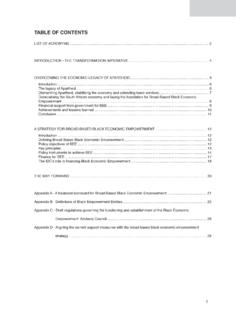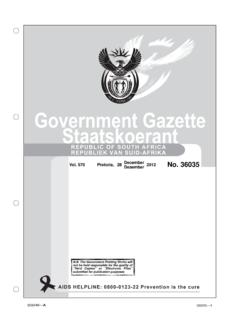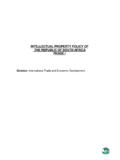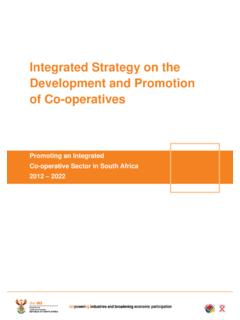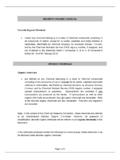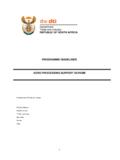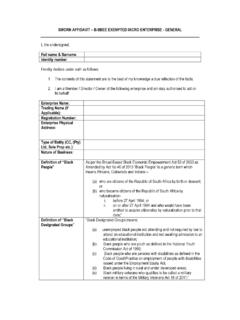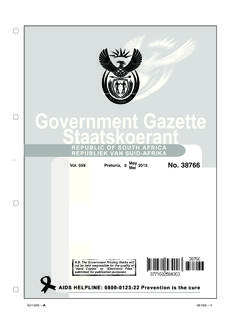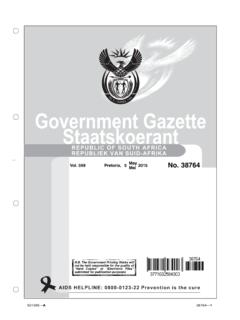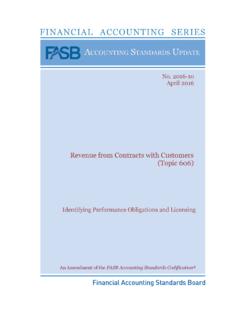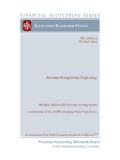Transcription of IFRS 15 Revenue from Contracts with Customers
1 May 2014. International Financial Reporting Standard . IFRS 15 Revenue from Contracts with Customers International Financial Reporting Standard 15. Revenue from Contracts with Customers IFRS 15 Revenue from Contracts with Customers is published by the International Accounting Standards Board (IASB). Disclaimer: the IASB, the IFRS Foundation, the authors and the publishers do not accept responsibility for any loss caused by acting or refraining from acting in reliance on the material in this publication, whether such loss is caused by negligence or otherwise. International Financial Reporting Standards (including International Accounting Standards and SIC and IFRIC Interpretations), Exposure Drafts and other IASB and/or IFRS Foundation publications are copyright of the IFRS Foundation.
2 Copyright 2014 IFRS Foundation . ISBN for this part: 978-1-909704-34-3; ISBN for the set of three parts: 978-1-909704-33-6. All rights reserved. No part of this publication may be translated, reprinted, reproduced or used in any form either in whole or in part or by any electronic, mechanical or other means, now known or hereafter invented, including photocopying and recording, or in any information storage and retrieval system, without prior permission in writing from the IFRS Foundation. The approved text of International Financial Reporting Standards and other IASB. publications is that published by the IASB in the English language. Copies may be obtained from the IFRS Foundation. Please address publications and copyright matters to: IFRS Foundation Publications Department 30 Cannon Street, London EC4M 6XH, United Kingdom Tel: +44 (0)20 7332 2730 Fax: +44 (0)20 7332 2749.
3 Email: Web: The IFRS Foundation logo/the IASB logo/the IFRS for SMEs logo/ Hexagon Device', IFRS. Foundation', eIFRS', IASB', IFRS for SMEs', IAS', IASs', IFRIC', IFRS', IFRSs', SIC', International Accounting Standards' and International Financial Reporting Standards' are Trade Marks of the IFRS Foundation. The IFRS Foundation is a not-for-profit corporation under the General Corporation Law of the State of Delaware, USA and operates in England and Wales as an overseas company (Company number: FC023235) with its principal office as above. INTERNATIONAL FINANCIAL REPORTING STANDARD. CONTENTS. from paragraph INTRODUCTION IN1. INTERNATIONAL FINANCIAL REPORTING STANDARD 15 Revenue FROM. Contracts with Customers . OBJECTIVE 1. Meeting the objective 2. SCOPE 5. RECOGNITION 9. Identifying the contract 9.
4 Combination of Contracts 17. contract modifications 18. Identifying performance obligations 22. Promises in Contracts with Customers 24. Distinct goods or services 26. Satisfaction of performance obligations 31. Performance obligations satisfied over time 35. Performance obligations satisfied at a point in time 38. Measuring progress towards complete satisfaction of a performance obligation 39. MEASUREMENT 46. Determining the transaction price 47. Variable consideration 50. The existence of a significant financing component in the contract 60. Non-cash consideration 66. Consideration payable to a customer 70. Allocating the transaction price to performance obligations 73. Allocation based on stand-alone selling prices 76. Allocation of a discount 81. Allocation of variable consideration 84.
5 Changes in the transaction price 87. contract COSTS 91. Incremental costs of obtaining a contract 91. Costs to fulfil a contract 95. Amortisation and impairment 99. PRESENTATION 105. DISCLOSURE 110. Contracts with Customers 113. Disaggregation of Revenue 114. contract balances 116. Performance obligations 119. Transaction price allocated to the remaining performance obligations 120. Significant judgements in the application of this Standard 123. Determining the timing of satisfaction of performance obligations 124. 3 IFRS Foundation IFRS 15 Revenue FROM Contracts with Customers . Determining the transaction price and the amounts allocated to performance obligations 126. Assets recognised from the costs to obtain or fulfil a contract with a customer 127. Practical expedients 129.
6 APPENDICES. A Defined terms B Application Guidance C Effective date and transition D Amendments to other Standards APPROVAL BY THE BOARD OF IFRS 15 Revenue FROM Contracts with . Customers ISSUED IN MAY 2014. BASIS FOR CONCLUSIONS (see separate booklet). APPENDICES. A Comparison of IFRS 15 and Topic 606. B Amendments to the Basis for Conclusions on other Standards ILLUSTRATIVE EXAMPLES (see separate booklet). APPENDIX. Amendments to the guidance on other Standards IFRS Foundation 4. INTERNATIONAL FINANCIAL REPORTING STANDARD. International Financial Reporting Standard 15 Revenue from Contracts with Customers (IFRS 15) is set out in paragraphs 1 129 and Appendices A D. All the paragraphs have equal authority. Paragraphs in bold type state the main principles. Terms defined in Appendix A are in italics the first time that they appear in the Standard.
7 Definitions of other terms are given in the Glossary for International Financial Reporting Standards. The Standard should be read in the context of its objective and the Basis for Conclusions, the Preface to International Financial Reporting Standards and the Conceptual Framework for Financial Reporting. IAS 8 Accounting Policies, Changes in Accounting Estimates and Errors provides a basis for selecting and applying accounting policies in the absence of explicit guidance. 5 IFRS Foundation IFRS 15 Revenue FROM Contracts with Customers . Introduction Overview IN1 International Financial Reporting Standard 15 Revenue from Contracts with Customers (IFRS 15) establishes principles for reporting useful information to users of financial statements about the nature, amount, timing and uncertainty of Revenue and cash flows arising from an entity's Contracts with Customers .
8 IN2 IFRS 15 is effective for annual periods beginning on or after 1 January 2017. Earlier application is permitted. IN3 IFRS 15 supersedes: (a) IAS 11 Construction Contracts ;. (b) IAS 18 Revenue ;. (c) IFRIC 13 customer Loyalty Programmes;. (d) IFRIC 15 Agreements for the Construction of Real Estate;. (e) IFRIC 18 Transfers of Assets from Customers ; and (f) SIC-31 Revenue Barter Transactions Involving Advertising Services. Reasons for issuing the IFRS. IN4 Revenue is an important number to users of financial statements in assessing an entity's financial performance and position. However, previous Revenue recognition requirements in International Financial Reporting Standards (IFRS). differed from those in US Generally Accepted Accounting Principles (US GAAP). and both sets of requirements were in need of improvement.
9 Previous Revenue recognition requirements in IFRS provided limited guidance and, consequently, the two main Revenue recognition Standards, IAS 18 and IAS 11, could be difficult to apply to complex transactions. In addition, IAS 18 provided limited guidance on many important Revenue topics such as accounting for multiple-element arrangements. In contrast, US GAAP comprised broad Revenue recognition concepts together with numerous Revenue requirements for particular industries or transactions, which sometimes resulted in different accounting for economically similar transactions. IN5 Accordingly, the International Accounting Standards Board (IASB) and the US. national standard-setter, the Financial Accounting Standards Board (FASB), initiated a joint project to clarify the principles for recognising Revenue and to develop a common Revenue standard for IFRS and US GAAP that would: (a) remove inconsistencies and weaknesses in previous Revenue requirements.
10 (b) provide a more robust framework for addressing Revenue issues;. (c) improve comparability of Revenue recognition practices across entities, industries, jurisdictions and capital markets;. IFRS Foundation 6. INTERNATIONAL FINANCIAL REPORTING STANDARD. (d) provide more useful information to users of financial statements through improved disclosure requirements; and (e) simplify the preparation of financial statements by reducing the number of requirements to which an entity must refer. IN6 IFRS 15, together with Topic 606 that was introduced into the FASB Accounting Standards Codification by Accounting Standards Update 2014-09 Revenue from Contracts with Customers (Topic 606), completes the joint effort by the IASB and the FASB to meet those objectives and improve financial reporting by creating a common Revenue recognition standard for IFRS and US GAAP.
